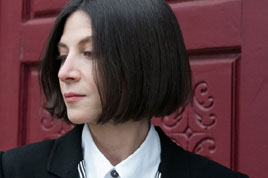The Child Who Reads Too Much - Interview with Donna Tartt - The Little Friend
The Bookseller, June 28, 2002
The child who read too much: Donna Tartt, author of The Secret History, has spent 10 years writing her second novel. She gives her first interview on the new book to the bookseller.
It is 10 years since the publication of Donna Tartt's The Secret History, the tale of a coterie of classics students who commit murder in the spirit of a bacchanalian rite. That debut novel became a publishing sensation after garnering a then extraordinary $450,000 advance from Knopf, and was a bestseller on both sides of the Atlantic (Penguin published in the UK). Now the trade is agog to see if Tartt can repeat that success with her long-awaited follow-up.
It is believed that a rumoured [pounds sterling]1m price tag for The Little Friend (Bloomsbury, 28th October, [pounds sterling]16.99, 0747562113) is overstated; nevertheless the price was certainly high, and there are expectations to match. Tartt's decision to disappear from public view while she wrote her second novel also contributes to the sense of fevered anticipation about her eventual return.
The Little Friend is set in 1970s Mississippi, the location of Tartt's own childhood. It is a big, expansive novel involving two very different families: the Cleves and the Ratliffs. The story opens with a devastating family tragedy: the death of a Cleve child, nine-year-old Robin, found mysteriously hanged--presumed murdered--from a tree in the family garden. Robin's sister Harriet is only a baby when the tragedy occurs, but years later, as a strong-willed 12-year-old who easily dominates her admiring playmates, Harriet becomes intensely curious about this unresolved episode in her family's history, the unspoken reason behind her mother's tranquilliser-fuelled abdication from life.
Piecing together information gleaned from family anecdotes, Harriet identifies a culprit in Robin's childhood schoolmate Danny Ratliff. But Danny has now grown up, arid as Harriet sets out on an adventurous plan to seek revenge for her brother's death, it becomes clear that Danny--and his druggy, exconvict brothers--are potentially dangerous men to cross.
Tartt, her Southern vowels clearly audible on the phone line from her home in Virginia, is robustly unapologetic about the long delay before the appearance of The Little Friend: "You can try to commodify writing, you can try to regulate it and make people turn it out, but in the end it is a process that is kind of organic. There are some flowers that only bloom every two years."
It is the process of writing the book that fascinates her more than the achievement of the final novel anyway, she says. "It is very analogous to getting into your car on the east coast and driving to California. It's a long journey, you're in your car for a long time, you have to enjoy the process of rambling and poking around, which I do--I think it's very evident, even in the way I build my sentences, that I like to meander."
At the same time, she felt she set herself new challenges this time around: "I wanted it to be a different, self-contained world that was just as real as the world of The Secret History, and it takes time to build up those layers of richness--you can't fake that. Also the style of this book was different: instead of a piece written for a single instrument, it was written for a full orchestra--a much broader range of characters and voices, and there were many technical difficulties in writing the book that I simply didn't face with The Secret History. So in that sense it's satisfying for me, and that's why it kept me engaged for all these years."
Tartt describes The Little Friend as a novel about how stories--whether the stories told in children's books, or the myths concocted within the family itself about its own past--can take on the quality of absolute truth in a child's mind. In that respect it bears some resemblance to The Secret History, whose characters also suffer from having taken their classical reading matter a little too seriously.
"The thoughts of other people do have a curious life in us, which is why literature is the most spiritual of all the arts," says Tartt. "The stories that are told to children have a particularly great pull, which they don't necessarily have in later life."
For her diminutive heroine Harriet, the stories are mostly those told by 19th-century British writers: Robert Louis Stevenson, Arthur Conan Doyle, Rudyard Kipling, Charles Dickens. These were the staples of Tartt's own childhood reading: "That's partly what it was like to grow up in Mississippi when I did. I read the books that my grandparents had read, and the books that were in the library. That is very much how the sensibility of this novel is formed, but also my sensibility as a writer--those were the books I read first and the formative ones."
Of no book was she more fond than of Robert Louis Stevenson's Treasure Island. She is particularly interested in its villains: "I think it is a very great book, and one of the best things about it is how Jim Hawkins has a very idealised view of going to sea, and yet you have the horror of old Blind Few. The pirates in that book aren't cartoon pirates, they are very, very frightening, in a very adult way." When she came to write The Little Friend, she says, she modelled the Ratliff boys on those same pirates.
She loved writing about Harriet's courageous adventures: "It's an old theme in literature even since the fairy tale, that children have nothing to use against 'the giant'--which can be Long John Silver, or in the case of Huck Finn, his own father-except their brains and their cunning in getting away."
But there is another strand of 19th-century literature--of which Henry James' What Maisie Knew is the classic example--that presents children in a different light: unable, despite and because of their forthright view of the world, to comprehend the complexities of adult behaviour. For James' Maisie it is the inability to understand how she is used as a pawn between two manipulative, warring parents; for Harriet it is an inexperience in life that leads her to treat family tales as gospel truth.
"Children see things very clearly but at the same time with an eye that's too naive to quite understand what they're seeing," observes Tartt, who adds that she found writing from the viewpoint of a child much more difficult than she had expected--write them as too advanced and they seem like adults, but too simple and you fall into the trap of making them cute.
The Mississippi setting is also a crucial dimension to The Little Friend, and one might expect for an author so preoccupied by other writers and other fictions that the legacy of the great Southern writers would loom large. Yet Tartt is suprisingly relaxed about writing in such a crowded literary landscape. She says she feels no indebtedness to William Faulkner: "If you follow the style of these admittedly great Southern writers a bit too closely, one ends up I think with a cliched 'South', and that is the problem with a lot of new Southern writing. My job is to see the place where I grew up with my own eyes, and I actually don't terribly enjoy reading Faulkner--he's a great writer, but not one of my favourites."
Nevertheless she believes that the late 20th-century Mississippi she is writing about is one that would have interested Faulkner greatly. In the 1970s, she says, the place was on the cusp of great change. When Tartt was a child, it had remained much the same for decades: she herself, it is said, grew up in the town of Grenada in a large house complete with maidservants; in The Little Friend, the Cleve sisters look back to the days spent in their grander family home, Tribulation, and they continue to live with black maidservants who in some cases have served the family for decades. Tartt describes Harriet's stinging shame at recognising that her mother is not happy for Ida, the nanny who has looked after her since babyhood, to drink out of the same cups as the family.
But with the 1970s, the 20th century finally came to Mississippi: "There was pop music and development and the highway system arrived, and new people came in. The character of the towns changed. This book kind of takes place on the cusp of the old and new South: when I was a little girl, my very early childhood was coloured by the struggle of the civil rights movements, and the change that I've seen in my lifetime is just absolutely remarkable."
Benedicte Page
* Donna Tartt will be visiting the UK in the week of publication to promote the book.
+ + + Comments + + +



